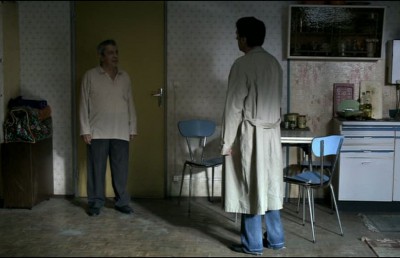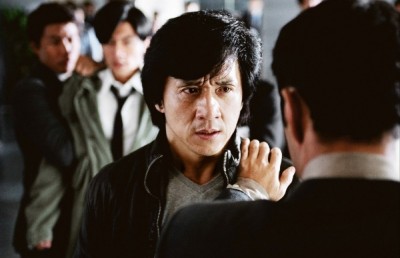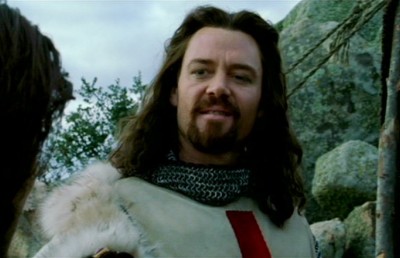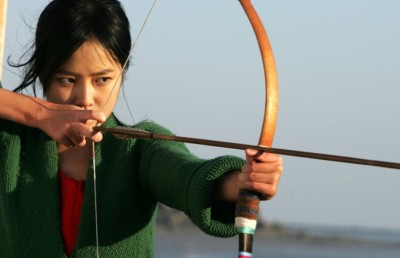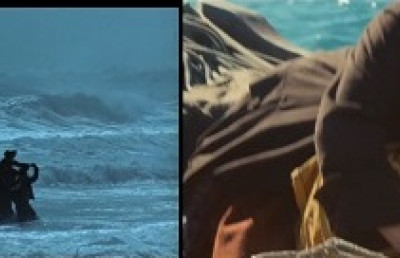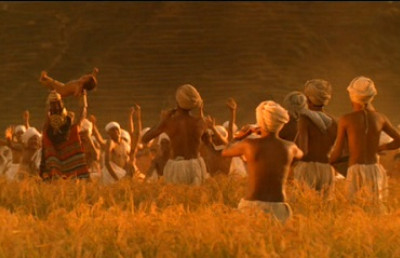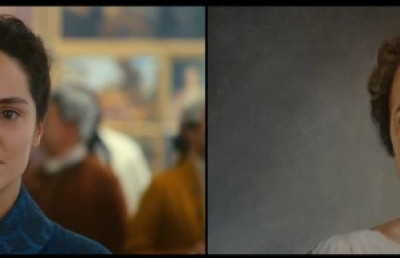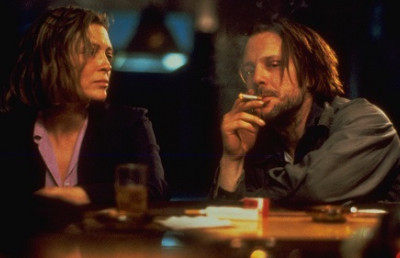The “Eternal” Interview with Federico Sanchez
Revisiting the Countess Bathory Tale
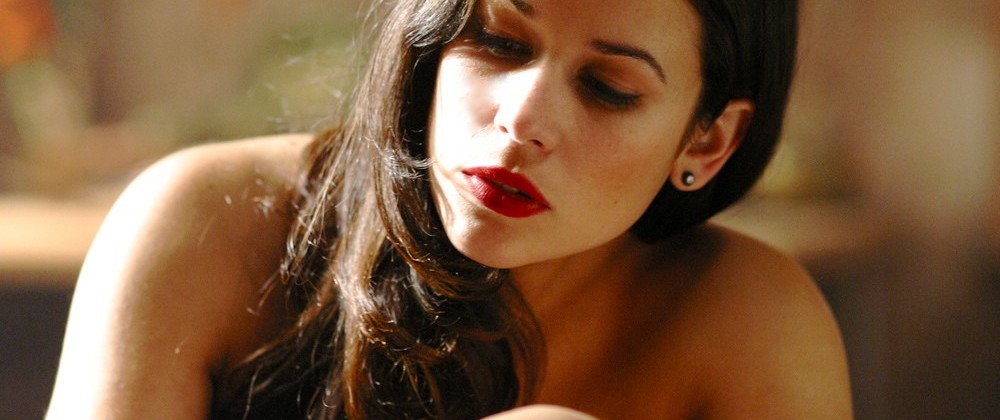
The Canadian film Eternal is the most recent of many films to be based on the legend of the infamous “Blood Countess” Elizabeth Bathory (1560-1614), a member of Hungarian royalty who believed that bathing in the blood of young women would keep her eternally young. Estimates on how many women she murdered vary, but some figures go as high as 650. There have been no shortage of films based on her, the best being Countess Dracula (1970, Peter Sasdy), Daughter of Darkness (1974 Harry Kümel), and Immoral Tales (1974, Walerian Borowczyk). Eternal adds a few new wrinkles to the timeless story, most notably setting the film in a contemporary urban context and introducing the possibility that the murderess Elizabeth Kane, played by the statuesque Caroline Néron, assumes the identity of the historical Bathory, rather than being the historical murderess, an outright descendent, or indeed, a vampire. The film also succeeds where some of the above mentioned better adaptations also did: in not holding back on the inherent carnality and sexuality of the original tale. The film stars Caroline Néron as the Bathory figure Elizabeth Kane; Victoria Sanchez as Kane’s protégé/servant Irina; and Conrad Pla as the detective tracking the case, Raymond Pope. I saw the digitally shot film projected on 35mm at the 2004 Fantasia International Film Festival and subsequently interviewed Federico Sanchez, who co-wrote and co-directed the film with Wilhelm Liebenberg. Be forewarned that this interview does contain plot spoilers.
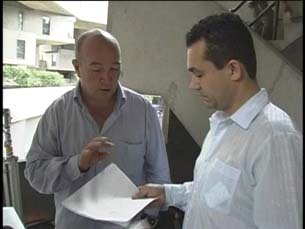
Offscreen: When was the film shot and what was the shooting schedule?
Federico Sanchez: It was shot in the summer and fall of 2003, in Italy and Montreal respectively. We waited for the fall to get those wonderful vibrant colors of dead leaves.
Offscreen: I know you shot in Montreal, Rome and Venice. Can you break up the amount of shooting days in each city?
Federico Sanchez: We spent 25 days in Montreal, eight days in Rome and three days in Venice. That was 3 days to get as much screen time as The Italian Job got in three weeks! We wrapped at 5:30 am the last morning and were on a plane back by 8 am.
Offscreen: How long did the film take from script to screen?
Federico Sanchez: We wrapped the script in September 2001, completed the shoot in October 2003, the post-production in May 2004 and the first public screening was in August 2004, when the movie was picked to close the Fantasia Film Festival, in Montreal. The US theatrical release will happen in September 2005.
Offscreen: What type of camera did you use?
Federico Sanchez: Sorry. Don’t know the exact model, but it was a Sony p24 (HD). I think it was the same model Lucas used for Star Wars, Episode I.
Offscreen: There is a “visual consultant” credit for Perri Gorrara. What did that comprise of?
Federico Sanchez: Essentially, we did a great portion of the art direction for the picture ourselves and Perry complimented our vision by suggesting sets, strange locations and unusual props, and by supervising any construction and design work required with her team. Perri worked on all the Montreal scenes, while Antonello Gelleng and Marina Pinzutti helped us set the tone in Italy, during the first part of the production.
Offscreen: How did the shared writing and directing proceed from a practical standpoint (i.e. how did you split up the writing; and how did you break up the on-set directing)?
Federico Sanchez: As strange as it may sound, in as far as the directing is concerned, we did not split up any responsibilities. There was a great fear at the beginning of the production that the egos and visions of two directors would clash. However, we know each other for 14 years and have been working together on various things since 2001. The reason we do movies together is because we want to tell the same stories and see the same things on screen. We have a polite process of consultation during the shoot and we arrive at our decisions well before we have to show up on set, so we can be of one mind. We can keep an eye out for each other, by constantly making sure that we are getting the maximum production value and not making as few foolish mistakes as possible. For the writing, we first agree on a concept out of many we shoot back and forth. Then, we create together a detailed scene-by-scene outline of the story, and then I tackle the physical writing of a first draft, with Wilhelm providing constant feedback as it progresses, until we arrive at our final draft. Then, during production, we are always looking out for ways to improve the story or to bring more value to the screen by doing re-writes on the spot, paying close attention to the advise of the most trusted members of our creative team.
SCRIPT/STORY/CHARACTERS
Offscreen: There have been many films based on the Countess Bathory story. What attracted you to the story? And did you see any other film versions before making yours?
Federico Sanchez: The first contact with the story happened when I was around 12 years old. I read a book about the history of crime. It contained the most horrendous cases of all time, far worse than any fiction, including the story of the savage countess. The book gave me nightmares the night I first read it. Years later, I approached Wilhelm with the premise of a history that would explore the premise of a modern-day Bathory, who could be a woman with the same psychosis or perhaps Bathory herself, still alive today. I had a chance to see Daughters of Darkness almost 13 years ago and was highly impressed by its wonderful style and its very unique take on the vampire genre. Strangely, I wouldn’t be able to tell you how it begins, details of the plot or how it ends, but the mood of that film still lingers in my head.
Offscreen: One of the things I liked about the script was its subtlety regarding the supernatural: Is Elizabeth the nearly 500 year old Countess, or does she just think she is? The script is written so that you can read it both ways. As co-writers, did you see “eye-to-eye” on this matter, or do you have differing views on whether Elizabeth is or isn’t a vampire?
Federico Sanchez: We are extremely glad you took the time to notice this aspect. We definitely saw eye-to-eye when it came to this subject. We tried to craft an unusual, sexual suspense thriller, with an original spin on vampirism. As to whether she is or not a vampire, we will live that decision to the public.
Offscreen: I love the line Elizabeth says before killing her victims, “I thank you for your beauty.” It captures both her sense of superiority (like the real Elizabeth, who preyed on poor peasant girls and women) and regal etiquette. Another clever line with nuance is when Irina leaves into the woods and tells the boy at the bus stop, “Nature calls.” The boy interprets the line one way (she is going to urinate) and we interpret it another way (her bloodlust). My sense is that the best lines, the ones with nuance and subtext, are given to the women (especially Elizabeth and Irina), which perhaps is a sign that you, as writers, ‘preferred’ the female characters. Would this be true?
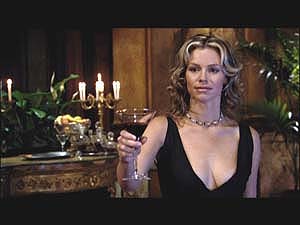
Federico Sanchez: This is absolutely true. Eternal was written to provide actresses with the opportunity to portray sexually powerful and deviant characters, in apparent control of their actions, something we rarely get to see in genre films.
Offscreen: Although your film is not sexually explicit, there are several ‘hot’ sex scenes (and some lesbian) and I am wondering if your film will remain uncut in the US and Canada? I ask because I know how prudish the US market can be, more so now under Bush.
Federico Sanchez: We were lucky there. Our distributor, Regent Releasing, supported by Columbia Tri-Star has made the bold move to release the picture theatrically uncut and unrated, since there was no way in hell we could avoid at least at R rating or an NC-17. We tried to keep our approach to the most difficult sex scenes suggestive and beautiful. We reduced the nudity to the “bare” minimum, but aimed to heighten the erotic feeling, to the point that many people who have seen the film are convinced that they saw nudity in scenes where there is actually none.
Offscreen: Along the same lines, the film’s sense of amorality, especially having the central character (Detective Pope) cheating with his wife’s partner, the sadomasochism, etc., I wonder how this will play out in the US with the Christian right climate?
Federico Sanchez: We really don’t know. I think that worse films have sneaked by the radar of the moral armies of America. It is true that Eternal is a story about amoral people with few redeeming qualities. Maybe we should run a contest and give a prize to the viewer who finds an innocent person.
Offscreen: In terms of how the characters were written, there is a parallel made between Raymond and Elizabeth, made clear with the cut from Elizabeth preying on Nancy (“Wildcat,” Pope’s wife played by Sarah Manninen) to Raymond Pope engaging in sadomasochism with Nancy. As Elizabeth later says to Raymond at the bar, “We seem to share some tastes in women.” This helps ‘confuse’ the film’s moral universe and makes the film more interesting (not a question here, just a comment!).
Federico Sanchez: The theme of deviant behavior runs throughout the film. Conrad Pla, the actor who portrays detective Raymond Pope, had to struggle constantly between his own good nature and the twisted mind of his cop. Even his terrible obsession with a powerful woman and a savage criminal like Elizabeth finds its roots in reality, in that same obsession (or desire) that possesses some rare women to fall in love with known serial killers and serial rapists. Even female judges have made marriage proposals to condemned murderers. Don’t ask us to explain that pathology. They are risk junkies, turned on by death.
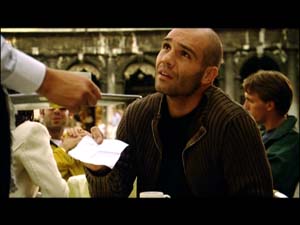
Offscreen: I also like the way the parallel between Raymond and Elizabeth is made visually in two sex scenes, when we see Elizabeth in the exact same position on top of Nancy, that we saw Nancy in with Raymond in an earlier scene. Was this a conscious choice or a case of creative serendipity?
Federico Sanchez: We must admit that this was a case of creative serendipity. The only link between the two was the natural positions of power of Elizabeth and Nancy. However, Nancy’s power results from Pope’s own desire for someone to take control.
Offscreen: A question on the bookstore scene in Venice. I know it was a necessary scene because of plot exposition, giving both the audience and the character background knowledge on Countess Bathory. It is, however, a fairly cliché scene which we’ve seen in many horror/thriller films. Were you at all hesitant about the writing of this scene?
Federico Sanchez: Judging by some of these questions, I believe your spirit was present when we shot the film. It is indeed the only expository monologue in the entire film and we did have our concerns. In the end, we found an Italian actor who was practically the character of the librarian in real life. He spoke several languages, including a couple of dead ones, and was a fountain of knowledge on numerous subjects. We loved the way he told a story. We took a chance and left the scene in the film for those people who have never heard of Bathory. Funny enough, it turned out to be one of the film’s favorite moments for some people.
VISUALS/STYLE
Offscreen: Here I go criticizing the bookstore scene and yet it has one of the most beautiful visual touches in the film: the light-water ripple effect we see outside the bookstore window behind Raymond. How was that shot achieved?
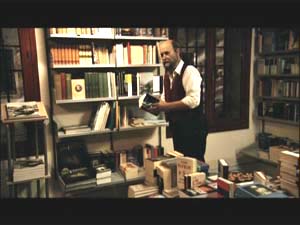
Federico Sanchez: To tell you the truth, that’s why we kept the scene. This is a good opportunity to throw deserving flowers to Jamie Thompson, the director of photography. He was our strongest and most trusted creative ally during the production of this film. He translated the vision in an impeccable way. Sure, we gave him pretty people and lovely places to shoot, but we could just walk away and trust that Jamie would deliver us fabulous photography, sometimes under very difficult time constraints. The shot of the water ripple effect was achieved, and I’m speaking for Jamie, by simply shining the right light, at the right angle on the canal. The trick was finding a bookstore in Venice with that kind of window overlooking a canal. The geography was real and you can even see a gondola going by if you look closely.
Offscreen: One of the impressive aspects of your film is the location work, sets, and art design (by Massimo Antonello Geleng and Marina Pinzuti). I know that most of your sets are actual locations in Montreal, Venice and Rome. But how much ‘set dressing’ did you have to do in the locations?
Federico Sanchez: Finding the right locations was the biggest part of our art direction. We think we drove our location scouts insane, but, in the end, they came through with flying colors. The Italian team of Geleng and Pinzuti were absolutely determined to find the exact places we wanted (or better) and would not rest until they succeeded. These are people who had done many more films than us, including some Federico Fellini and Dario Argento pictures. And yet, they treated us, first time directors from Montreal, with the same respect and dedication. We will never forget that. Most of the locations were great canvases, but we still had to do tremendous amounts of set dressing, especially when it came to choosing the right furniture. Both Marina Pinzutti, in Italy, and Susan Young, in Montreal, were instrumental in this process, scavenging obscure stores for our weirdest requests.
Offscreen: For example, in the early scenes at Elizabeth’s mansion we see a modern, stark red plastic chair amongst all the regal and antique pieces. I imagine the chair was added by your art direction team. I have my reasons why the chair could have been added, but I’d like to hear your response.
Federico Sanchez: That was one of the weird requests mentioned above. Wilhelm is a passionate of set dressing, having designed himself boutiques, restaurants and hotels. He introduced the concept of breaking up Elizabeth’s classical furniture with some strange, eclectic pieces. This particular red chair, so dear to Wilhelm, was not only representative of blood, but it introduced a timeless element of Italian design from the fifties, a period that inspired greatly the style of the film. A lot of the stylistic choices, including costumes, vehicles and make up, were driven by this theme of timelessness, making it hard to pin point the exact decade of the action. By the way, the chair is plastic, but, boy, was it ever expensive!
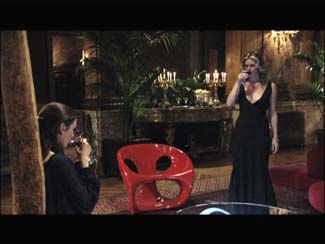
Offscreen: This may be a stupid question given how beautiful and photogenic Venice is, but why did you have Bathory heading off to Venice? Why not to her ‘roots’ in East Europe? Were you at all “intimidated” by the city’s history and visual beauty? Were you inspired by any of the other great “Venice” films, like Death in Venice, Don’t Look Now, Nosferatu in Venice?
Federico Sanchez: I would love to see Nosferatu in Venice! The real Bathory was rumored to travel often to the most decadent European cities. We chose Venice because it represented perfectly one of the main themes of Eternal: a dangerous and sexual element hidden under a façade of irresistible beauty. Very few people know that the famous Venice carnival was banned two hundred years ago by Napoleon, when the city was under French rule. The festivities had become so sexually decadent that the emperor had to put an end to them. The gorgeous masks were mere tools to conceal the identity of sexual offenders. The word itself comes form the Italian Carne Vale, or to “take flesh”.
Offscreen: Kudos to the appropriately sleazy sex orgy scene near the end. I think it was more effective, in terms of capturing social decadence and sexual temptation, than Kubrick’s similar orgy scene in Eyes Wide Shut [which many critics have rightly compared it to]. Regards that scene, how much of the set was ‘found’ and how much was ‘dressed.’ Particularly, there is the amazing bath/fountain that Bathory prepares to use. The statues of the supplicating females fits your story so perfectly. Was that dressed at all?
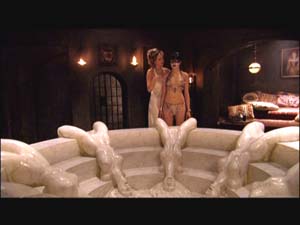
Federico Sanchez: At one point, we had been advised to not go to Venice and to shoot everything in Rome to save money and make everyone’s life easier. We still decided to go on a scouting trip. The house where this orgy takes place was the clincher. We had to shoot there. We walked inside this place and we immediately felt an aura of power and the presence of something sinister. The building is now a music academy. We were later told by its director that the mansion had belonged to the Casonis, one of the wealthiest families of the Venetian republic. It had a secret room that had once been the only Masonic lodge in the city. The giant metal lights on the walls had belonged to the sunken galleons of the Venetian army and had been retrieved from the bottom of the ocean by the Casonis, as a tribute to thousands of dead soldiers. The courtyard had a mysterious statue of a veiled woman missing a hand, whose origins nobody knew. All these things appear in the film. We had no choice but to go there. The design of the final sacrificial bath came out of our deviant minds and was later improved upon and built from scratch by Antonello Geleng. It’s still out there somewhere in Italy, probably used for some pleasurable activities.
Offscreen: All the women in your film are pretty much drop dead gorgeous, and you can’t say the same about the men! It made me think of a contentious quote from Dario Argento: “I like women, especially beautiful ones. If they have a good face and a good figure, I would much prefer to watch them being murdered than an ugly girl.” Would you say that sums up your aesthetic approach to death in this film?
Federico Sanchez: The lead villainess in Eternal is seeking to preserve her own youth and beauty through consuming the blood of young and beautiful women. The choice of a stunning female cast results from this need. We feel that the choice of every actress and every gorgeous and unusual-looking extra ultimately added to the overall sexual energy of the picture and, certainly, to the beauty of it. We have been pleasantly surprised by the positive reactions we have received from women, mostly due to the fact that the female characters, although extremely sexy, remain in control. Only one male character engages in intense sexual situations: detective Pope. With his ex-kickboxer body and rugged bad boy looks, we think that Conrad Pla will strike a chord with a great number of ladies. Of course, the number of beautiful women far surpasses the men, but, after all, didn’t Bathory kill 650 maids?
Offscreen: I was pleasantly surprised by the song you used to introduce the Venice scenes. I thought for sure I would hear an Italian song, but instead it is Charles Arznevour singing “Que c’est triste Venise.” It is a clever selection because it quickly establishes the mood of Venice as a melancholic, romantic place. How long did it take you to select that particular song?
Federico Sanchez: It immediately came to mind, but we debated its use. On one hand, it is one of the most famous songs, if not THE most famous song about Venice, making it perhaps the obvious choice. On the other hand, it echoes perfectly the spirit of the film: perversion in beauty. It speaks of lost love and sadness in one of the world’s most romantic and beautiful cities. Many of the songs in the film are famous classic love songs, with a sinister or tragic undertone. “Mona Lisa,” for example, one of the most romantic pieces of all time, which we used in the opening scene, has a line that says: “Many dreams have come to your doorstep; some just lie there, some just die there”.
CASTING/ACTING
Offscreen: I think Caroline Néron makes a perfect Countess Bathory. Her physique, screen presence, movements, accent, all fit the exotic, “foreign” image we have of Bathory. How long did it take for you to cast her?
Federico Sanchez: To get the film financed as unknown directors, we shot a pilot of three scenes from the script. Three days before the first day of photography, we hadn’t found anyone in Montreal that convinced us in the role of the devious and sexy Elizabeth Kane. The agent of Victoria Sanchez, Sandy Martinez, called us to see if we would be interested in meeting with this major French Canadian TV star and award-nominated actress, Caroline Néron. Since we don’t watch that much French TV, we did not know her, nor the fact that, besides her talent as an actress, she had been voted a couple of times as the sexiest woman in Quebec. We met her with her agent and, to our surprise, she bought into our pitch and accepted the role. However, we had never seen her act in anything, so we requested to see an audition. Instead of kicking us out the door, Caroline agreed to meet us at an equipment rental facility, where we were testing the camera, and read a scene in the middle of a corridor busy with technicians. What we saw in the little monitor was magic. Her voice, her presence and her looks just reminded us of those great movie stars of days gone by. She shot the pilot, then the feature film and now we are proud to bring her to a theatre near you.
Offscreen: I also think Victoria Sanchez is excellent in her role. In terms of casting, Caroline Néron as Elizabeth and Victoria Sanchez as Irina are an ideal pairing, one being tall and blond, the other shorter and dark haired. They play off each other well and have a nice chemistry together. Elizabeth kills with class, Irina kills with lust. Their relationship is an interesting mixture of parental (mother/daughter), fraternal (sister/sister), and sexual (lovers). How did you direct them in this latter sense, in terms of how they behave with each other?
Federico Sanchez: Their relationship is at the core one of master and servant, with the various nuances mentioned above. It is similar in many ways to the long-term relationships of some serial killers that act in pairs. One leads by creating a twisted fantasy world, while the other follows, moved by a strong desire to belong and to please. Elizabeth needs to have Irina as her pupil and servant, both to satisfy her emotional need of companionship and her feeling of superiority and to provide her with victims. On the other side, Irina sees Elizabeth as this extraordinary supernatural being with the coveted secret of “eternal” life. Issues of doubt and trust start to affect their relationship, as Elizabeth keeps pushing the day she will grant Irina her gift and the young disciple struggles with her own natural desires and criminal tendencies, which appear to contradict those of Elizabeth (the sophisticated and sensual taking of a woman’s soul versus the brutal, ruthless murder of men).
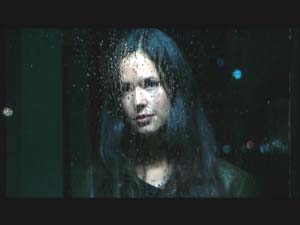
Offscreen: I was less sure of Conrad Pla, but as the film went on I grew to understand how we was a good fit for this “bad lieutenant-type” role. Even if he is overwhelmed by Caroline Néron in their scenes together, that was more to do with their characters than their acting. What sort of instructions did you give them in their scenes together?
Federico Sanchez: Detective Pope is like Maldoror, that French figure of literature that comes face to face with a killer shark in the water and falls in love with it. The shark returns the feeling, but we know that ultimately the relationship is doomed because of the savage nature of the animal. To begin with, we believe that most of the directing is done at the time of casting. Both Conrad and Caroline are meticulous actors that will continue to ask the right questions until their choices become clear. As directors, we were there to answer these questions and to put a situation in perspective, because we ultimately trusted our actors. For the rest, we followed Hitchcock’s advise: shoot your fights like love scenes, and your love scenes like fights.
FILMIC REFERENCES
Offscreen: This is a long shot. The line which Detective Raymond Pope says to Elizabeth, “Did you have sex with my wife,” was that a reference to the famous line from Raging Bull, where De Niro asks Pesci, “Did you fuck my wife?”
Federico Sanchez: Raging Bull is one of my favorite films. I am thrilled that you make this reference, but we must confess that it was totally subconscious.
Offscreen: The name she assumes in the film, Elizabeth Kane, is “Kane” a reference to Welles’ Citizen Kane? I ask because her mansion does have the isolated feel of Kane’s estate, “Xanadu.”
Federico Sanchez: It is. Not only do we love the film and the character, but we admire the maverick way in which Orson Welles got his movie made: He shot a pilot, so people would believe him. Elizabeth’s estate definitely draws inspiration from Xanadu.
Offscreen: The final jail scene seemed to owe something to Silence of the Lambs, the way you have a detective visiting a ‘sophisticated’ serial killer, who tempts and teases the detective with her phrases, like “Have some wine,” her sexuality, etc. Also the way it is framed through and across the prison bars. In some of the shot counter shots we don’t see bars in front of Elizabeth, but do see bars in front of Raymond, which makes it look like he is in prison, not her. Also, what is interesting about this ending is the way Elizabeth is “imprisoned.” She has all the comforts of home in her cell, right down to her portrait. Even in prison she is treated like royalty, which relates to the real Elizabeth, who, because she was monarchy, was locked up in a room in her castle until her death, rather than executed or imprisoned outside. Was this your way of adapting the real story to film?
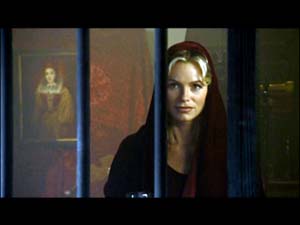
Federico Sanchez: Yes. You describe it accurately. Without spoiling the ending, we will just say that the church is somehow involved in her imprisonment. Here, we hint to the fact that the church has always believed in the existence of supernatural individuals. The last Pope sanctified more people that all the previous Popes combined in the last 500 years. A condition for sanctification is the ability to perform at least one proven miracle, before or AFTER death. This is supernatural. It is highly possible that not all people on this list are supernatural, even though the Pope may be convinced of it. Also, in the old days, aristocrats were often allowed to bring their possession and, sometimes, their servants to prison. This historical detail shows that the jailers are convinced that they are dealing with royalty.
Offscreen: I like the shot where Irina is sharpening her fangs and in the background we see Betty Page on the television. Betty Page has quite a cult following among straight men and gay women. Just curious, why Betty Page?
Federico Sanchez: Betty Page was suggested by Victoria Sanchez herself, as she was preparing for the role. She was auditioning for a Betty Page film and got access to some old erotic dances of the famous pinup. She instinctively felt that her character would find such weird films appealing and would love to watch them. Thus, the choice was made. You are the first person to identify this footage. I wonder what else you keep in your basement….!
Offscreen: Final question: any possibility (or interest on your part) for a sequel!
Federico Sanchez: The film is open for a prequel and the sequel. We have been approached for both, plus the possibility of turning the story into an HBO-style TV series, following the crime spree of Elizabeth and Irina, as they travel from city to city, evading the authorities and luring new victims to their doom. I (and Wilhelm) thank you for the opportunity to do this wonderful interview and we sincerely hope your readers will enjoy the film.



